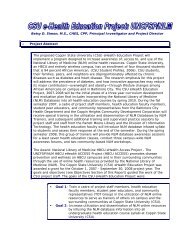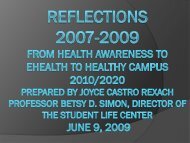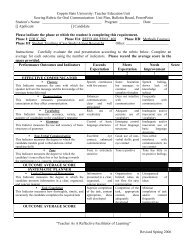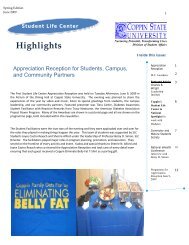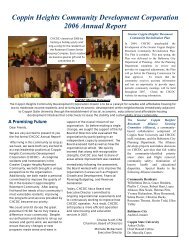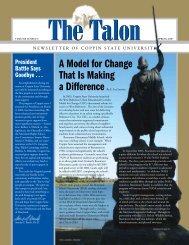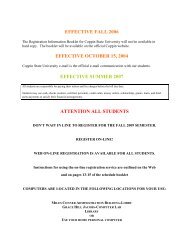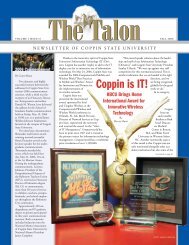Betsy D. Simon, Coordinator The National Diabetes Goal: Turning ...
Betsy D. Simon, Coordinator The National Diabetes Goal: Turning ...
Betsy D. Simon, Coordinator The National Diabetes Goal: Turning ...
Create successful ePaper yourself
Turn your PDF publications into a flip-book with our unique Google optimized e-Paper software.
<strong>Betsy</strong> D. <strong>Simon</strong>, <strong>Coordinator</strong><br />
<strong>The</strong> <strong>National</strong> <strong>Diabetes</strong> <strong>Goal</strong>: <strong>Turning</strong><br />
the Tide of Pre-<strong>Diabetes</strong> in America<br />
By: Manan Shah<br />
<strong>Diabetes</strong>, especially type 2, is increasing<br />
at an alarming rate in the United States.<br />
This rapid rise is being fueled by an aging<br />
population, rising rates of obesity and<br />
more sedentary lifestyles. While genetics<br />
plays a role, we know that diabetes and<br />
its complications can often be delayed or<br />
prevented through lifestyle changes such<br />
as exercise and healthy eating. Preventing<br />
and managing diabetes may not be an<br />
easy task, but with improved awareness<br />
and action, it is possible.<br />
Managing diabetes involves a balance of<br />
healthy eating, prescription medication<br />
and physical activity that can often be<br />
overwhelming. Many people who are<br />
newly diagnosed with diabetes don’t know<br />
where to begin. People with diabetes must<br />
have access to information to help them<br />
make healthy choices, take control of their<br />
own care, and remain motivated to stay<br />
on track.<br />
Recently, the Centers for Disease Control<br />
and Prevention (CDC) reported new<br />
statistics on the prevalence of diabetes.<br />
While the headlines focused on the 23.6<br />
million Americans—roughly eight percent<br />
of the population—who currently have<br />
diabetes, there is another number that<br />
poses a great risk and potential<br />
opportunity for the country: 57 million<br />
Americans have pre-diabetes, a condition<br />
where a person’s blood glucose level is<br />
higher than normal but not yet high<br />
enough to be diagnosed as diabetes.<br />
Recent research has shown that even in<br />
this condition, long-term damage to the<br />
body, including the heart and circulatory<br />
system, may already be occurring.<br />
Additionally, there is also the growing<br />
economic burden of diabetes in America.<br />
In mid-November, research conducted by<br />
<strong>The</strong> Lewin Group and commissioned by<br />
the <strong>National</strong> Changing <strong>Diabetes</strong>®<br />
Program found that the cost of diabetes<br />
was an estimated $218 billion in 2007<br />
due to higher medical expenditures and<br />
lost productivity. Of that, $25 billion was<br />
attributes to those 57 million Americans<br />
with pre-diabetes. “In individuals with<br />
pre-diabetes, we observed a significant<br />
increase in ambulatory visits for a wide<br />
variety of medical conditions, including<br />
hypertension, endocrine, metabolic and<br />
kidney complications,” said Tim Dall, vice<br />
president at <strong>The</strong> Lewin Group.<br />
<strong>Diabetes</strong> does not have to be inevitable.<br />
People with pre-diabetes can take action<br />
to manage their blood glucose levels and<br />
reverse the course to diabetes.<br />
That is why the <strong>National</strong> <strong>Diabetes</strong> <strong>Goal</strong><br />
was established. <strong>The</strong> need for a <strong>National</strong><br />
<strong>Diabetes</strong> <strong>Goal</strong> was highlighted in 2008 by<br />
the results of a Gallup survey funded by<br />
Novo Nordisk, titled Public Knowledge,<br />
Perceptions and Behavior Regarding<br />
<strong>Diabetes</strong> and <strong>Diabetes</strong> Prevention: A<br />
Societal Barometer. This survey brought<br />
to light the public’s perception of<br />
diabetes and the amount of knowledge<br />
about the disease that exists among the<br />
general population.<br />
Almost all survey respondents (94%)<br />
considered diabetes to be a serious<br />
health issue. <strong>The</strong> poll showed that one in<br />
four adults (24%) have either been<br />
diagnosed by a physician as having
diabetes (9%) or as being at-risk for<br />
diabetes (15%). <strong>The</strong> survey results<br />
revealed that high awareness about<br />
diabetes had not yet translated into<br />
action to prevent the disease, and it was<br />
this fact that led a coalition of diabetes<br />
stakeholders to develop the <strong>National</strong><br />
<strong>Diabetes</strong> <strong>Goal</strong>: By 2015%, 45% of<br />
American who are at risk for diabetes will<br />
know their blood glucose level and what<br />
actions to take.<br />
In addition to calling on the American<br />
public to learn about the consequences of<br />
uncontrolled diabetes and the importance<br />
of being tested, the <strong>National</strong> <strong>Diabetes</strong><br />
<strong>Goal</strong> emphasizes action. Blood glucose<br />
testing is only the first step in preventing<br />
diabetes; people who are at risk must also<br />
educate themselves on what the test<br />
results mean, and take the necessary next<br />
steps to stay in control of their health.<br />
<strong>The</strong> American <strong>Diabetes</strong> Association<br />
identifies several risk factors associated<br />
with type 2 diabetes. <strong>The</strong>y include a<br />
family history of diabetes or heart<br />
disease, being overweight or obese,<br />
being physically inactive, and having<br />
high blood pressure or triglycerides or<br />
low HDL cholesterol. African Americans,<br />
Hispanics, Native Americans, Asian<br />
Americans and Pacific Islanders are also<br />
at higher risk for developing diabetes.<br />
Confirming the important role that family<br />
history and genetics play in diabetes, a<br />
recent report in the Journal of the<br />
American Medical Association estimates<br />
that one in three boys and two in five<br />
girls born in the year 2000 are at risk to<br />
develop diabetes in their lifetime, this<br />
number increases to one in two for<br />
minority children born that year.<br />
<strong>Diabetes</strong> is more common in African<br />
Americans, Latinos, Native Americans,<br />
and Asian Americans/Pacific Islanders.<br />
This means these groups are also at<br />
increased risk for developing prediabetes.<br />
50 other health, advocacy, business and<br />
educational organizations across the<br />
country that are committed to reversing<br />
the diabetes epidemic in the United<br />
States.<br />
Here at Coppin, I am thrilled that ehealth<br />
educators, other healthy campus 2010<br />
students, faculty, staff, and<br />
administrators such as <strong>Betsy</strong> <strong>Simon</strong>, are<br />
taking the values of the <strong>Goal</strong> to heart<br />
and working to make a difference on<br />
campus and in the community. Initiatives<br />
such as the “Eliminate Belly Fat<br />
Campaign @ Coppin,” which includes onsite<br />
weight watchers classes, 3 times<br />
weekly physical activities (line-dancing,<br />
hand dancing), healthy snacks events,<br />
and the Wednesdays @ Noon <strong>Diabetes</strong><br />
Awareness Sessions are great ways to<br />
engage and educate those who may be<br />
at risk or encourage them to tell friends<br />
and family.<br />
Each organization that supports the<br />
<strong>National</strong> <strong>Diabetes</strong> <strong>Goal</strong> is working to<br />
reach out to its audience and<br />
constituents to spread the message of<br />
diabetes awareness and action. If you<br />
would like to learn more information<br />
about this initiative, please visit<br />
www.<strong>National</strong><strong>Diabetes</strong><strong>Goal</strong>.com or<br />
contact <strong>Betsy</strong> <strong>Simon</strong> at<br />
bsimon@coppin.edu to learn what you<br />
can do at Coppin!<br />
K M. Venkat Narayan, et. al. Lifetime<br />
Risk for <strong>Diabetes</strong> Mellitus in the United<br />
States. JAMA, Oct 2003; 290: 1884 -<br />
1890.<br />
Currently, the <strong>Goal</strong> is championed by<br />
Coppin State University and more than





